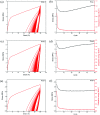Mechanical properties of an interpenetrating network poly(vinyl alcohol)/alginate hydrogel with hierarchical fibrous structures
- PMID: 35432947
- PMCID: PMC9008709
- DOI: 10.1039/d1ra07368k
Mechanical properties of an interpenetrating network poly(vinyl alcohol)/alginate hydrogel with hierarchical fibrous structures
Abstract
Bioinspired hierarchical fibrous structures were constructed in an interpenetrating poly(vinyl alcohol, PVA)/alginate hydrogel network to improve its mechanical properties. The interpenetrating hydrogel network with hierarchical fibrous structures was prepared by combining the confined drying method and freeze-thaw method. First, Ca2+ cross-linked alginate formed a nano-micro hierarchical fibrous structure via the confined drying method. Then, PVA that was uniformly distributed among the Ca2+-alginate chains was cross-linked by hydrogen bonding via the freeze-thaw method, further dividing the hierarchical fibers into finer fibers. The results of a tensile test demonstrated that both the tensile stress and fracture energy improved by more than double after the introduction of 2 wt% PVA, achieving a combination of high strength (∼12.9 MPa), high toughness (∼13.2 MJ m-3) and large strain (∼161.4%). Cyclic tensile tests showed that a hysteresis loop existed on the loading-unloading curves of the hydrogel along the fibrous directions, and a good self-recovery property emerged after resting for a period of time. The hydrogel with hierarchical fibrous structures constructed by alginate and PVA can be employed in biomedical applications in the future.
This journal is © The Royal Society of Chemistry.
Conflict of interest statement
There are no conflicts to declare.
Figures








Similar articles
-
Alginate Fiber-Enhanced Poly(vinyl alcohol) Hydrogels with Superior Lubricating Property and Biocompatibility.Polymers (Basel). 2022 Sep 28;14(19):4063. doi: 10.3390/polym14194063. Polymers (Basel). 2022. PMID: 36236011 Free PMC article.
-
How can multi-bond network hydrogels dissipate energy more effectively: an investigation on the relationship between network structure and properties.Soft Matter. 2020 May 13;16(18):4407-4413. doi: 10.1039/d0sm00455c. Soft Matter. 2020. PMID: 32323693
-
Strong, tough and mechanically self-recoverable poly(vinyl alcohol)/alginate dual-physical double-network hydrogels with large cross-link density contrast.RSC Adv. 2018 May 8;8(30):16674-16689. doi: 10.1039/c8ra01302k. eCollection 2018 May 3. RSC Adv. 2018. PMID: 35540543 Free PMC article.
-
Fluorinated Graphene Thermally Conductive Hydrogel with a Solid-Liquid Interpenetrating Heat Conduction Network.ACS Appl Mater Interfaces. 2024 Jan 10;16(1):1451-1460. doi: 10.1021/acsami.3c14478. Epub 2023 Dec 19. ACS Appl Mater Interfaces. 2024. PMID: 38112199
-
A facile method to fabricate high performance PVA/PAA-AS hydrogel via the synergy of multiple hydrogen bonding and Hofmeister effect.J Biomater Sci Polym Ed. 2023 Feb;34(2):243-257. doi: 10.1080/09205063.2022.2115759. Epub 2022 Aug 29. J Biomater Sci Polym Ed. 2023. PMID: 36005479
Cited by
-
Skin-Inspired Ultra-Tough Supramolecular Multifunctional Hydrogel Electronic Skin for Human-Machine Interaction.Nanomicro Lett. 2023 Apr 13;15(1):102. doi: 10.1007/s40820-023-01084-8. Nanomicro Lett. 2023. PMID: 37052831 Free PMC article.
-
Dual-Responsive Alginate/PNIPAM Microspheres Fabricated by Microemulsion-Based Electrospray.Polymers (Basel). 2024 Sep 30;16(19):2765. doi: 10.3390/polym16192765. Polymers (Basel). 2024. PMID: 39408475 Free PMC article.
-
Mechanically robust eutectogels enabled by precisely engineered crystalline domains.Nat Commun. 2025 Aug 11;16(1):7417. doi: 10.1038/s41467-025-62742-6. Nat Commun. 2025. PMID: 40790118 Free PMC article.
-
Poly(vinyl alcohol)/modified porous starch gel beads for microbial preservation and reactivation: preparation, characterization and its wastewater treatment performance.RSC Adv. 2023 Oct 13;13(43):30217-30229. doi: 10.1039/d3ra05371g. eCollection 2023 Oct 11. RSC Adv. 2023. PMID: 37842668 Free PMC article.
-
Tunable Alginate-Polyvinyl Alcohol Bioinks for 3D Printing in Cartilage Tissue Engineering.Gels. 2024 Dec 14;10(12):829. doi: 10.3390/gels10120829. Gels. 2024. PMID: 39727587 Free PMC article.
References
-
- Zhuang Y. Yu F. Chen H. Zheng J. Ma J. Chen J. Alginate/graphene Double-Network Nanocomposite Hydrogel Beads with Low-swelling, Enhanced Mechanical Properties, and Enhanced Adsorption Capacity. J. Mater. Chem. A. 2016;4:10885–10892. doi: 10.1039/C6TA02738E. - DOI
LinkOut - more resources
Full Text Sources
Other Literature Sources
Miscellaneous

